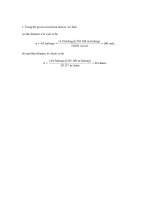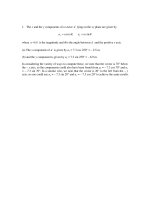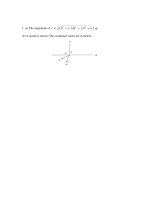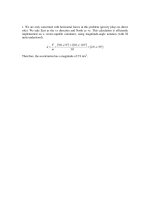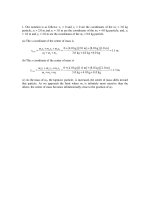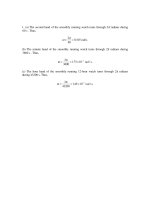Solution manual fundamentals of physics extended, 8th editionch15
Bạn đang xem bản rút gọn của tài liệu. Xem và tải ngay bản đầy đủ của tài liệu tại đây (1.02 MB, 115 trang )
1. (a) The amplitude is half the range of the displacement, or xm = 1.0 mm.
(b) The maximum speed vm is related to the amplitude xm by vm = ωxm, where ω is the
angular frequency. Since ω = 2πf, where f is the frequency,
vm = 2π fxm = 2π (120 Hz ) (1.0 ×10 −3 m ) = 0.75 m/s.
(c) The maximum acceleration is
am = ω 2 xm = ( 2π f ) xm = ( 2π (120 Hz ) ) (1.0 ×10−3 m ) = 5.7 ×102 m/s 2 .
2
2
2. (a) The acceleration amplitude is related to the maximum force by Newton’s second
law: Fmax = mam. The textbook notes (in the discussion immediately after Eq. 15-7) that
the acceleration amplitude is am = ω2xm, where ω is the angular frequency (ω = 2πf since
there are 2π radians in one cycle). The frequency is the reciprocal of the period: f = 1/T =
1/0.20 = 5.0 Hz, so the angular frequency is ω = 10π (understood to be valid to two
significant figures). Therefore,
b
gb
g b0.085 mg = 10 N.
Fmax = mω 2 xm = 0.12 kg 10π rad / s
2
(b) Using Eq. 15-12, we obtain
ω=
k
2
k = ( 0.12kg )(10π rad/s ) = 1.2 ×102 N/m.
m
3. (a) The angular frequency ω is given by ω = 2πf = 2π/T, where f is the frequency and T
is the period. The relationship f = 1/T was used to obtain the last form. Thus
ω = 2π/(1.00 × 10–5 s) = 6.28 × 105 rad/s.
(b) The maximum speed vm and maximum displacement xm are related by vm = ωxm, so
1.00 × 103 m / s
xm =
=
= 1.59 × 10−3 m.
5
ω 6.28 × 10 rad / s
vm
4. The textbook notes (in the discussion immediately after Eq. 15-7) that the acceleration
amplitude is am = ω2xm, where ω is the angular frequency (ω = 2πf since there are 2π
radians in one cycle). Therefore, in this circumstance, we obtain
c b
am = 2 π 6.60 Hz
2
gh b0.0220 mg = 37.8 m / s .
2
5. (a) The motion repeats every 0.500 s so the period must be T = 0.500 s.
(b) The frequency is the reciprocal of the period: f = 1/T = 1/(0.500 s) = 2.00 Hz.
(c) The angular frequency ω is ω = 2πf = 2π(2.00 Hz) = 12.6 rad/s.
(d) The angular frequency is related to the spring constant k and the mass m by
ω = k m . We solve for k: k = mω2 = (0.500 kg)(12.6 rad/s)2 = 79.0 N/m.
(e) Let xm be the amplitude. The maximum speed is vm = ωxm = (12.6 rad/s)(0.350 m) =
4.40 m/s.
(f) The maximum force is exerted when the displacement is a maximum and its
magnitude is given by Fm = kxm = (79.0 N/m)(0.350 m) = 27.6 N.
6. (a) The problem describes the time taken to execute one cycle of the motion. The
period is T = 0.75 s.
(b) Frequency is simply the reciprocal of the period: f = 1/T ≈ 1.3 Hz, where the SI unit
abbreviation Hz stands for Hertz, which means a cycle-per-second.
(c) Since 2π radians are equivalent to a cycle, the angular frequency ω (in radians-persecond) is related to frequency f by ω = 2πf so that ω ≈ 8.4 rad/s.
7. (a) During simple harmonic motion, the speed is (momentarily) zero when the object is
at a “turning point” (that is, when x = +xm or x = –xm). Consider that it starts at x = +xm
and we are told that t = 0.25 second elapses until the object reaches x = –xm. To execute a
full cycle of the motion (which takes a period T to complete), the object which started at x
= +xm must return to x = +xm (which, by symmetry, will occur 0.25 second after it was at
x = –xm). Thus, T = 2t = 0.50 s.
(b) Frequency is simply the reciprocal of the period: f = 1/T = 2.0 Hz.
(c) The 36 cm distance between x = +xm and x = –xm is 2xm. Thus, xm = 36/2 = 18 cm.
8. (a) Since the problem gives the frequency f = 3.00 Hz, we have ω = 2πf = 6π rad/s
(understood to be valid to three significant figures). Each spring is considered to support
one fourth of the mass mcar so that Eq. 15-12 leads to
ω=
k
k=
mcar / 4
1
2
(1450kg )( 6π rad/s ) = 1.29 ×105 N/m.
4
(b) If the new mass being supported by the four springs is mtotal = [1450 + 5(73)] kg =
1815 kg, then Eq. 15-12 leads to
ω new =
k
mtotal / 4
f new =
1
2π
1.29 ×105 N/m
= 2.68Hz.
(1815 / 4) kg
9. (a) Making sure our calculator is in radians mode, we find
FG b g π IJ = 3.0 m.
H
3K
x = 6.0 cos 3π 2.0 +
(b) Differentiating with respect to time and evaluating at t = 2.0 s, we find
v=
b g FGH b g IJK
dx
π
= −3π 6.0 sin 3π 2.0 +
= −49 m / s.
dt
3
(c) Differentiating again, we obtain
a=
b g b6.0gcosFGH 3πb2.0g + π3 IJK = −2.7 × 10
dv
= − 3π
dt
2
2
m / s2 .
(d) In the second paragraph after Eq. 15-3, the textbook defines the phase of the motion.
In this case (with t = 2.0 s) the phase is 3π(2.0) + π/3 ≈ 20 rad.
(e) Comparing with Eq. 15-3, we see that ω = 3π rad/s. Therefore, f = ω/2π = 1.5 Hz.
(f) The period is the reciprocal of the frequency: T = 1/f ≈ 0.67 s.
10. We note (from the graph) that xm = 6.00 cm. Also the value at t = 0 is xo = − 2.00 cm.
Then Eq. 15-3 leads to f = cos−1(−2.00/6.00) = +1.91 rad or – 4.37 rad. The other “root”
(+4.37 rad) can be rejected on the grounds that it would lead to a positive slope at t = 0.
11. When displaced from equilibrium, the net force exerted by the springs is –2kx acting
in a direction so as to return the block to its equilibrium position (x = 0). Since the
acceleration a = d2x/dt2, Newton’s second law yields
m
d2x
= −2 kx.
dt 2
Substituting x = xm cos(ωt + φ) and simplifying, we find
ω2 =
2k
m
where ω is in radians per unit time. Since there are 2π radians in a cycle, and frequency f
measures cycles per second, we obtain
f=
ω
1
=
2π 2π
2k 1
=
m 2π
2(7580 N/m)
= 39.6 Hz.
0.245 kg
12. We note (from the graph) that vm = ωxm = 5.00 cm/s. Also the value at t = 0 is vo =
4.00 cm/s. Then Eq. 15-6 leads to φ = sin−1(− 4.00/5.00) = – 0.927 rad or +5.36 rad.
The other “root” (+4.07 rad) can be rejected on the grounds that it would lead to a
positive slope at t = 0.
13. The magnitude of the maximum acceleration is given by am = ω2xm, where ω is the
angular frequency and xm is the amplitude.
(a) The angular frequency for which the maximum acceleration is g is given by
ω = g / x m , and the corresponding frequency is given by
f=
ω
1
=
2π 2π
g
1
=
xm 2π
9.8 m/s 2
= 498 Hz.
1.0 ×10−6 m
(b) For frequencies greater than 498 Hz, the acceleration exceeds g for some part of the
motion.
14. From highest level to lowest level is twice the amplitude xm of the motion. The period
is related to the angular frequency by Eq. 15-5. Thus, x m = 12 d and ω = 0.503 rad/h. The
phase constant φ in Eq. 15-3 is zero since we start our clock when xo = xm (at the highest
point). We solve for t when x is one-fourth of the total distance from highest to lowest
level, or (which is the same) half the distance from highest level to middle level (where
we locate the origin of coordinates). Thus, we seek t when the ocean surface is at
x = 12 x m = 14 d .
x = xm cos(ωt + φ )
FG IJ b
H K
1
1
d=
d cos 0.503t + 0
4
2
1
= cos(0.503t )
2
g
which has t = 2.08 h as the smallest positive root. The calculator is in radians mode
during this calculation.
15. The maximum force that can be exerted by the surface must be less than µsFN or else
the block will not follow the surface in its motion. Here, µ s is the coefficient of static
friction and FN is the normal force exerted by the surface on the block. Since the block
does not accelerate vertically, we know that FN = mg, where m is the mass of the block. If
the block follows the table and moves in simple harmonic motion, the magnitude of the
maximum force exerted on it is given by F = mam = mω2xm = m(2πf)2xm, where am is the
magnitude of the maximum acceleration, ω is the angular frequency, and f is the
frequency. The relationship ω = 2πf was used to obtain the last form. We substitute F =
m(2πf)2xm and FN = mg into F < µ sFN to obtain m(2πf)2xm < µ smg. The largest amplitude
for which the block does not slip is
xm =
b0.50gc9.8 m / s h = 0.031 m.
b2πf g b2π × 2.0 Hzg
2
µsg
2
=
2
A larger amplitude requires a larger force at the end points of the motion. The surface
cannot supply the larger force and the block slips.
16. The statement that “the spring does not affect the collision” justifies the use of elastic
collision formulas in section 10-5. We are told the period of SHM so that we can find the
mass of block 2:
m2
T = 2π
k
kT 2
m2 = 2 = 0.600 kg.
4π
At this point, the rebound speed of block 1 can be found from Eq. 10-30:
| v1 f | =
0.200 - 0.600
| 0.200
| (8.00 m/s)
+ 0.600
= 4.00 m/s .
This becomes the initial speed v0 of the projectile motion of block 1. A variety of choices
for the positive axis directions are possible, and we choose left as the +x direction and
down as the +y direction, in this instance. With the “launch” angle being zero, Eq. 4-21
and Eq. 4-22 (with –g replaced with +g) lead to
x – x0 = v0 t = v0
Since x – x0 = d, we arrive at d = 4.00 m.
2h
= (4.00)
g
2(4.90)
9.8
17. (a) Eq. 15-8 leads to
a = −ω 2 x ω =
123
−a
=
0100
.
x
which yields ω = 35.07 rad/s. Therefore, f = ω/2π = 5.58 Hz.
(b) Eq. 15-12 provides a relation between ω (found in the previous part) and the mass:
ω=
400 N/m
k
m=
= 0.325kg.
(35.07 rad/s) 2
m
(c) By energy conservation, 12 kxm2 (the energy of the system at a turning point) is equal to
the sum of kinetic and potential energies at the time t described in the problem.
1 2 1 2 1 2
m
kxm = mv + kx xm = v 2 + x 2 .
2
2
2
k
Consequently, xm = (0.325 / 400)(13.6)2 + (0.100) 2 = 0.400m.
18. We note that the ratio of Eq. 15-6 and Eq. 15-3 is v/x = –ωtan(ωt + φ) where ω = 1.20
rad/s in this problem. Evaluating this at t = 0 and using the values from the graphs shown
in the problem, we find
φ = tan−1(–vo/xoω) = tan−1(+4.00/(2 × 1.20)) =1.03 rad (or –5.25 rad).
One can check that the other “root” (4.17 rad) is unacceptable since it would give the
wrong signs for the individual values of vo and xo.
19. Eq. 15-12 gives the angular velocity:
ω=
100 N/m
k
=
= 7.07rad/s.
m
2.00 kg
Energy methods (discussed in §15-4) provide one method of solution. Here, we use
trigonometric techniques based on Eq. 15-3 and Eq. 15-6.
(a) Dividing Eq. 15-6 by Eq. 15-3, we obtain
v
= −ω tan ωt + φ
x
b
g
so that the phase (ωt + φ) is found from
ωt + φ = tan −1
FG −v IJ = tan
H ωx K
−1
F −3.415 I .
GH b7.07gb0.129gJK
With the calculator in radians mode, this gives the phase equal to –1.31 rad. Plugging this
back into Eq. 15-3 leads to 0.129m = xm cos( −1.31) xm = 0.500m.
(b) Since ωt + φ = –1.31 rad at t = 1.00 s, we can use the above value of ω to solve for the
phase constant φ. We obtain φ = –8.38 rad (though this, as well as the previous result, can
have 2π or 4π (and so on) added to it without changing the physics of the situation). With
this value of φ, we find xo = xm cos φ = – 0.251 m.
(c) And we obtain vo = –xmω sinφ = 3.06 m/s.
20. Both parts of this problem deal with the critical case when the maximum acceleration
becomes equal to that of free fall. The textbook notes (in the discussion immediately after
Eq. 15-7) that the acceleration amplitude is am = ω2xm, where ω is the angular frequency;
this is the expression we set equal to g = 9.8 m/s2.
(a) Using Eq. 15-5 and T = 1.0 s, we have
FG 2π IJ
HTK
2
xm = g xm =
gT 2
= 0.25 m.
4π2
(b) Since ω = 2πf, and xm = 0.050 m is given, we find
( 2π f )
2
xm = g
f=
1
2π
g
= 2.2 Hz.
xm
21. (a) Let
x1 =
FG IJ
H K
A
2 πt
cos
2
T
be the coordinate as a function of time for particle 1 and
x2 =
FG
H
A
2 πt π
cos
+
2
T
6
IJ
K
be the coordinate as a function of time for particle 2. Here T is the period. Note that since
the range of the motion is A, the amplitudes are both A/2. The arguments of the cosine
functions are in radians. Particle 1 is at one end of its path (x1 = A/2) when t = 0. Particle
2 is at A/2 when 2πt/T + π/6 = 0 or t = –T/12. That is, particle 1 lags particle 2 by onetwelfth a period. We want the coordinates of the particles 0.50 s later; that is, at t = 0.50 s,
x1 =
A
§ 2π × 0.50 s ·
cos ¨
¸ = −0.25 A
2
© 1.5 s ¹
and
x2 =
A
§ 2π × 0.50 s π ·
cos ¨
+ ¸ = −0.43 A.
2
6¹
© 1.5 s
Their separation at that time is x1 – x2 = –0.25A + 0.43A = 0.18A.
(b) The velocities of the particles are given by
v1 =
F I
H K
dx1 πA
2 πt
sin
=
dt
T
T
and
v2 =
F
H
I
K
dx2 πA
2 πt π
sin
=
+ .
dt
T
T
6
We evaluate these expressions for t = 0.50 s and find they are both negative-valued,
indicating that the particles are moving in the same direction.
22. They pass each other at time t, at x1 = x2 = 12 xm where
x1 = xm cos(ωt + φ 1 )
and
x2 = xm cos(ωt + φ 2 ).
From this, we conclude that cos(ωt + φ 1 ) = cos(ωt + φ 2 ) = 12 , and therefore that the phases
(the arguments of the cosines) are either both equal to π/3 or one is π/3 while the other
is –π/3. Also at this instant, we have v1 = –v2Ћ0 where
v1 = − xmω sin(ωt + φ 1 )
and
v2 = − xmω sin(ωt + φ 2 ).
This leads to sin(ωt + φ1) = – sin(ωt + φ 2). This leads us to conclude that the phases have
opposite sign. Thus, one phase is π/3 and the other phase is –π /3; the wt term cancels if
we take the phase difference, which is seen to be π /3 – (–π /3) = 2π /3.
23. (a) The object oscillates about its equilibrium point, where the downward force of
gravity is balanced by the upward force of the spring. If " is the elongation of the spring
at equilibrium, then k" = mg , where k is the spring constant and m is the mass of the
object. Thus k m = g " and
a f
f = ω 2 π = 1 2π
a f
k m = 1 2π
g ".
Now the equilibrium point is halfway between the points where the object is momentarily
at rest. One of these points is where the spring is unstretched and the other is the lowest
point, 10 cm below. Thus " = 5.0 cm = 0.050 m and
f=
1
2π
9.8 m/s 2
= 2.2 Hz.
0.050 m
(b) Use conservation of energy. We take the zero of gravitational potential energy to be at
the initial position of the object, where the spring is unstretched. Then both the initial
potential and kinetic energies are zero. We take the y axis to be positive in the downward
direction and let y = 0.080 m. The potential energy when the object is at this point is
U = 12 ky 2 − mgy . The energy equation becomes 0 = 12 ky 2 − mgy + 12 mv 2 . We solve for the
speed.
v = 2 gy −
§ 9.8 m/s 2 ·
k 2
g
2
y = 2 gy − y 2 = 2 ( 9.8 m/s 2 ) ( 0.080 m ) − ¨
¸ = ( 0.080 m )
m
"
© 0.050 m ¹
= 0.56 m/s
(c) Let m be the original mass and ∆m be the additional mass. The new angular frequency
is ω ′ = k / ( m + ∆m) . This should be half the original angular frequency, or 12 k m . We
solve k / ( m + ∆m) = 12 k / m for m. Square both sides of the equation, then take the
reciprocal to obtain m + ∆m = 4m. This gives m = ∆m/3 = (300 g)/3 = 100 g = 0.100 kg.
(d) The equilibrium position is determined by the balancing of the gravitational and
spring forces: ky = (m + ∆m)g. Thus y = (m + ∆m)g/k. We will need to find the value of
the spring constant k. Use k = mω2 = m(2π f )2. Then
2
m + ∆m ) g ( 0.100 kg + 0.300 kg ) ( 9.80 m/s )
(
y
=
= 0.200 m.
2
2
m ( 2π f )
( 0.100 kg )( 2π × 2.24 Hz )
This is measured from the initial position.
24. Let the spring constants be k1 and k2. When displaced from equilibrium, the
magnitude of the net force exerted by the springs is |k1x + k2 x| acting in a direction so as
to return the block to its equilibrium position (x = 0). Since the acceleration a = d2x/d2,
Newton’s second law yields
m
d 2x
= − k1 x − k 2 x.
dt 2
Substituting x = xm cos(ωt + φ) and simplifying, we find
ω2 =
k1 + k 2
m
where ω is in radians per unit time. Since there are 2π radians in a cycle, and frequency f
measures cycles per second, we obtain
f =
ω
2π
=
1
2π
k1 + k 2
.
m
The single springs each acting alone would produce simple harmonic motions of
frequency
f1 =
1
2π
k1
= 30 Hz,
m
f2 =
1
2π
k2
= 45 Hz,
m
respectively. Comparing these expressions, it is clear that
f =
f12 + f 22 = (30 Hz) 2 +(45 Hz) 2 = 54 Hz.
25. To be on the verge of slipping means that the force exerted on the smaller block (at
the point of maximum acceleration) is fmax = µ s mg. The textbook notes (in the discussion
immediately after Eq. 15-7) that the acceleration amplitude is am =ω2xm, where
ω = k / (m + M ) is the angular frequency (from Eq. 15-12). Therefore, using Newton’s
second law, we have
mam = µ s mg
which leads to xm = 0.22 m.
k
xm = µ s g
m+ M
